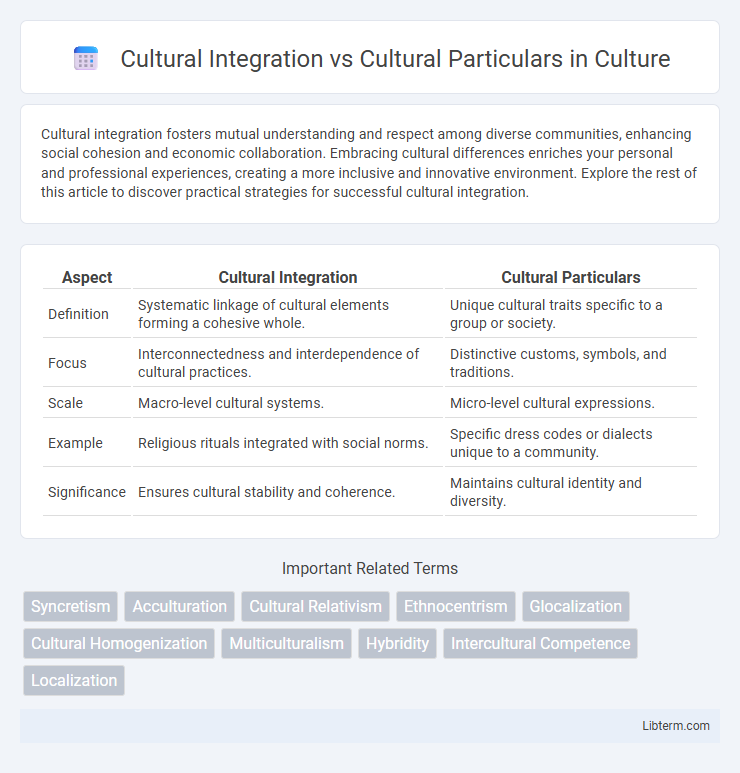Cultural integration fosters mutual understanding and respect among diverse communities, enhancing social cohesion and economic collaboration. Embracing cultural differences enriches your personal and professional experiences, creating a more inclusive and innovative environment. Explore the rest of this article to discover practical strategies for successful cultural integration.
Table of Comparison
| Aspect | Cultural Integration | Cultural Particulars |
|---|---|---|
| Definition | Systematic linkage of cultural elements forming a cohesive whole. | Unique cultural traits specific to a group or society. |
| Focus | Interconnectedness and interdependence of cultural practices. | Distinctive customs, symbols, and traditions. |
| Scale | Macro-level cultural systems. | Micro-level cultural expressions. |
| Example | Religious rituals integrated with social norms. | Specific dress codes or dialects unique to a community. |
| Significance | Ensures cultural stability and coherence. | Maintains cultural identity and diversity. |
Understanding Cultural Integration
Cultural integration refers to the process through which diverse cultural groups come to coexist harmoniously by blending customs, values, and practices while maintaining their unique identities. Understanding cultural integration involves recognizing how shared norms and social structures develop, enabling cooperation and mutual respect among different communities. Effective cultural integration supports social cohesion and economic development by fostering inclusivity without erasing cultural particulars.
Defining Cultural Particulars
Cultural particulars refer to specific customs, traditions, and practices unique to a distinct group or society that define its identity within a broader cultural context. These elements include language, rituals, cuisine, dress, and social norms that differentiate one culture from another and preserve historical continuity. Understanding cultural particulars is essential for appreciating diversity and fostering respectful cultural integration without erasing unique heritage.
Historical Contexts of Cultural Blending
Historical contexts of cultural blending reveal the dynamic interplay between cultural integration and cultural particulars, where societies merge distinct traditions while preserving unique identities. Empires like the Roman and Ottoman exemplify cultural integration by adopting and adapting customs from diverse populations, fostering unified yet pluralistic civilizations. Simultaneously, indigenous practices and localized rituals endure as cultural particulars, highlighting resilience amid assimilation and enriching the tapestry of global heritage.
Key Drivers of Integration
Key drivers of cultural integration include shared values, effective communication, and mutual respect, which foster cohesion within diverse environments. Organizational policies promoting inclusivity and cross-cultural collaboration enhance understanding and reduce conflicts. Emphasizing common goals while respecting cultural particulars ensures a balanced approach to integration that leverages diversity as a strategic asset.
Examples of Cultural Particulars Worldwide
Cultural particulars manifest in diverse expressions such as Japan's tea ceremony, India's Diwali festival, and Mexico's Day of the Dead, each reflecting unique customs and values tied to specific communities. These particulars underscore distinctive rituals, attire, and culinary traditions that differentiate one culture from another worldwide. Emphasizing local context, cultural particulars provide vital insights into the social fabric and historical identity of societies.
Benefits of Embracing Integration
Embracing cultural integration enhances social cohesion by fostering mutual understanding and respect among diverse groups, leading to inclusive communities where innovation thrives through shared knowledge. It promotes economic growth as integrated cultures combine unique skills and perspectives, driving creativity and competitive advantage in global markets. This approach reduces cultural conflicts and supports harmonious living, benefiting education, business, and governance by creating adaptable and resilient societies.
Challenges Facing Cultural Particulars
Cultural particulars face significant challenges such as preserving unique traditions and languages amid globalization pressures that favor cultural integration. These challenges include the risk of cultural homogenization, loss of identity, and difficulties in maintaining intergenerational transmission of customs. Efforts to protect cultural diversity require strategic policies that balance respect for cultural particulars while promoting social cohesion.
Balancing Integration and Identity
Balancing cultural integration and cultural particulars requires respecting unique cultural identities while fostering social cohesion in diverse societies. Effective integration policies promote shared values without erasing distinct traditions, enabling communities to maintain their heritage alongside broader societal participation. This equilibrium supports both individual identity affirmation and collective harmony, enhancing social stability and mutual understanding.
Case Studies in Cultural Adaptation
Case studies in cultural adaptation reveal critical distinctions between cultural integration and cultural particulars, highlighting how multinational organizations balance global brand consistency with local cultural nuances. For instance, McDonald's adapts its menu offerings in India by excluding beef products to respect local dietary practices while maintaining its core brand identity worldwide. Such examples underscore the importance of understanding specific cultural particulars to achieve successful integration in diverse markets without diluting cultural uniqueness.
Future Trends in Cultural Dynamics
Future trends in cultural dynamics emphasize a balance between cultural integration and cultural particulars, where globalization drives interconnectedness but also fuels the preservation of unique identities. Emerging technologies and digital platforms facilitate cross-cultural exchange while enabling communities to maintain and showcase distinctive traditions and values. This dual movement fosters a dynamic interplay that shapes evolving social norms and organizational practices worldwide.
Cultural Integration Infographic

 libterm.com
libterm.com